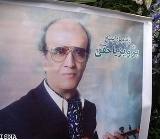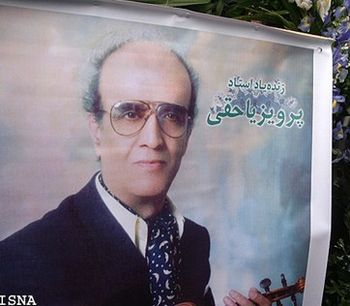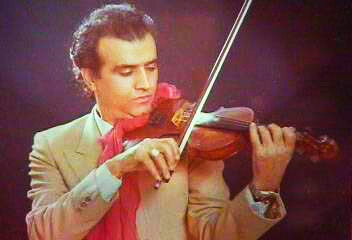
Parviz Yahaghi
Encyclopedia
Parviz Yahaghi was a distinguished Iranian composer and violinist. He was born in Tehran
in 1936 and died in Tehran in 2007.
,whitened,rotated,cropped.jpg)
 His birth name was Parviz Sedighi Parsi. He was musically educated primarily by his uncle Hossein Yahaghi, a violinist and violin teacher, and adopted the Yahaghi name. During his youth he was exposed to many highly professional musicians in Tehran who were friends of his uncle. A notable visitor at his uncle's house was the violin teacher, composer, and musicologist Abolhasan Saba
His birth name was Parviz Sedighi Parsi. He was musically educated primarily by his uncle Hossein Yahaghi, a violinist and violin teacher, and adopted the Yahaghi name. During his youth he was exposed to many highly professional musicians in Tehran who were friends of his uncle. A notable visitor at his uncle's house was the violin teacher, composer, and musicologist Abolhasan Saba
, who is credited with introducing improvements in violin playing technique in the Persian tradition. Saba published a two-volume training manual for the violin in 1944-45. Starting from about 20 years of age Yahaghi was employed for many years as a musician with the Iranian government-financed radio station. In the 1960s and 1970s he composed hundreds of pieces both for violin and for celebrated singers in Iran such as Banan, Marzieh, Delkash, Pouran, Elahe, Homeyra, Mahasti, Dariush Rafei, Homayoonpour, and Iraj (Hossein Khajeh Amiri). These compositions were often produced in connection with the long-running radio program Golha. Yahaghi's ability in playing violin, his compositions, and his musical director's role made him a central figure in Persian music during his lifetime. Yahaghi's violin is tuned in a way that gives different resonances and drones to the sound, compared to standard European tuning, and he uses a number of different tuning schemes.
Yahaghi had already resigned from the government radio station before the arrival of 1979 political revolution in Iran, and he set up a recording studio of his own in Tehran. In the wake of the revolution many of Yahaghi's friends and associates departed from Iran and did not return. But Yahaghi stayed. His wife, Homeyra
, one of Iran's most famous singers, moved permanently to the USA without him. (The revolutionaries outlawed female solo singing, though women were free to continue to play musical instruments and to sing in choruses.) Yahaghi was arrested, interrogated, and released by the new regime. During the 1980s with the war between Iran and Iraq going on, he was invited by the regime to compose music, particularly patriotic music. He declined. But the official authorities came around to viewing him with such esteem that after his death some of his musical instruments, recording equipment and other items were appropriated as national and historic property.
 Parviz Yahaghi's most widely distributed recordings outside Iran is, perhaps, the five-volume "Persian Melodies" collection (five compact discs). The four-volume album "Violin Melodies" is the same thing as the first four volumes of Persian Melodies. Other albums by Yahaghi currently in print include "Toreh" in two volumes (i.e. two compact discs); "Tooba" (a.k.a. Tobi) in two volumes; "Taravat" in two volumes; the three-volume set headlined "Iranian Classical Music" whose three volumes are called Ashk & Tulu, Yad, and Faryad; and other albums by Yahaghi in print include "Kimia", "Saz-e Del", "Mehr", "Mahtab", and "Raaz & Niyaz". These albums don't contain any overlap in recorded material with themselves or with the Violin Melodies collection, although at times one hears some recurring themes being reworked and replayed. All these albums are instrumental only (no singing) and monophonic only. (The many early recordings of Yahaghi playing with a singer are published under the singer's name).
Parviz Yahaghi's most widely distributed recordings outside Iran is, perhaps, the five-volume "Persian Melodies" collection (five compact discs). The four-volume album "Violin Melodies" is the same thing as the first four volumes of Persian Melodies. Other albums by Yahaghi currently in print include "Toreh" in two volumes (i.e. two compact discs); "Tooba" (a.k.a. Tobi) in two volumes; "Taravat" in two volumes; the three-volume set headlined "Iranian Classical Music" whose three volumes are called Ashk & Tulu, Yad, and Faryad; and other albums by Yahaghi in print include "Kimia", "Saz-e Del", "Mehr", "Mahtab", and "Raaz & Niyaz". These albums don't contain any overlap in recorded material with themselves or with the Violin Melodies collection, although at times one hears some recurring themes being reworked and replayed. All these albums are instrumental only (no singing) and monophonic only. (The many early recordings of Yahaghi playing with a singer are published under the singer's name).
Additional instrumental music featuring Yahaghi is available from the Taknavazan Collection. This collection consists of forty compact discs of Persian traditional instrumental music, featuring the violin on the majority of the tracks (the kamancheh features on about a third of the remainder). Yahaghi plays violin on at least one track on at least 25 of the 40 compact discs (and the discs have four tracks each, typically).http://www.musicboxla.com/taknavazan.html The other violinists in the Persian tradition who are present in this Taknavazan Collection are Ali Tajvidi
(علی تجویدی), Habibollah Badiei (حبیب الله بدیعی), Homayoun Khorram (همايون خرم), and Asadollah Malek (اسدالله ملک), all of whom were students of Abolhasan Saba in Tehran, and are similar to Yahaghi in aesthetics and technique.
Tehran
Tehran , sometimes spelled Teheran, is the capital of Iran and Tehran Province. With an estimated population of 8,429,807; it is also Iran's largest urban area and city, one of the largest cities in Western Asia, and is the world's 19th largest city.In the 20th century, Tehran was subject to...
in 1936 and died in Tehran in 2007.
,whitened,rotated,cropped.jpg)

Abolhasan Saba
Abol Hasan Sabā , was a renowned Iranian musician, composer, violinist, and setar player.-Biography:He was born in Tehran to Abul Qasim Khan Kamal ol-Saltaneh, son of Mohammad Jafar Khan Sadr ol-Hekma, son of Mahmud Khan Kashi Malak ol-Shoara Sadr ol-Shoara Saba ol-Shoara, son of Mohammad Hossain...
, who is credited with introducing improvements in violin playing technique in the Persian tradition. Saba published a two-volume training manual for the violin in 1944-45. Starting from about 20 years of age Yahaghi was employed for many years as a musician with the Iranian government-financed radio station. In the 1960s and 1970s he composed hundreds of pieces both for violin and for celebrated singers in Iran such as Banan, Marzieh, Delkash, Pouran, Elahe, Homeyra, Mahasti, Dariush Rafei, Homayoonpour, and Iraj (Hossein Khajeh Amiri). These compositions were often produced in connection with the long-running radio program Golha. Yahaghi's ability in playing violin, his compositions, and his musical director's role made him a central figure in Persian music during his lifetime. Yahaghi's violin is tuned in a way that gives different resonances and drones to the sound, compared to standard European tuning, and he uses a number of different tuning schemes.
Yahaghi had already resigned from the government radio station before the arrival of 1979 political revolution in Iran, and he set up a recording studio of his own in Tehran. In the wake of the revolution many of Yahaghi's friends and associates departed from Iran and did not return. But Yahaghi stayed. His wife, Homeyra
Homeyra
Parvaneh Amir-Afshari also known as Homeyra is an Iranian singer. She is a veteran celebrity of Iran's Golden Years of music. Her voice has been measured to span three octaves.-Early life:...
, one of Iran's most famous singers, moved permanently to the USA without him. (The revolutionaries outlawed female solo singing, though women were free to continue to play musical instruments and to sing in choruses.) Yahaghi was arrested, interrogated, and released by the new regime. During the 1980s with the war between Iran and Iraq going on, he was invited by the regime to compose music, particularly patriotic music. He declined. But the official authorities came around to viewing him with such esteem that after his death some of his musical instruments, recording equipment and other items were appropriated as national and historic property.
 Parviz Yahaghi's most widely distributed recordings outside Iran is, perhaps, the five-volume "Persian Melodies" collection (five compact discs). The four-volume album "Violin Melodies" is the same thing as the first four volumes of Persian Melodies. Other albums by Yahaghi currently in print include "Toreh" in two volumes (i.e. two compact discs); "Tooba" (a.k.a. Tobi) in two volumes; "Taravat" in two volumes; the three-volume set headlined "Iranian Classical Music" whose three volumes are called Ashk & Tulu, Yad, and Faryad; and other albums by Yahaghi in print include "Kimia", "Saz-e Del", "Mehr", "Mahtab", and "Raaz & Niyaz". These albums don't contain any overlap in recorded material with themselves or with the Violin Melodies collection, although at times one hears some recurring themes being reworked and replayed. All these albums are instrumental only (no singing) and monophonic only. (The many early recordings of Yahaghi playing with a singer are published under the singer's name).
Parviz Yahaghi's most widely distributed recordings outside Iran is, perhaps, the five-volume "Persian Melodies" collection (five compact discs). The four-volume album "Violin Melodies" is the same thing as the first four volumes of Persian Melodies. Other albums by Yahaghi currently in print include "Toreh" in two volumes (i.e. two compact discs); "Tooba" (a.k.a. Tobi) in two volumes; "Taravat" in two volumes; the three-volume set headlined "Iranian Classical Music" whose three volumes are called Ashk & Tulu, Yad, and Faryad; and other albums by Yahaghi in print include "Kimia", "Saz-e Del", "Mehr", "Mahtab", and "Raaz & Niyaz". These albums don't contain any overlap in recorded material with themselves or with the Violin Melodies collection, although at times one hears some recurring themes being reworked and replayed. All these albums are instrumental only (no singing) and monophonic only. (The many early recordings of Yahaghi playing with a singer are published under the singer's name).Additional instrumental music featuring Yahaghi is available from the Taknavazan Collection. This collection consists of forty compact discs of Persian traditional instrumental music, featuring the violin on the majority of the tracks (the kamancheh features on about a third of the remainder). Yahaghi plays violin on at least one track on at least 25 of the 40 compact discs (and the discs have four tracks each, typically).http://www.musicboxla.com/taknavazan.html The other violinists in the Persian tradition who are present in this Taknavazan Collection are Ali Tajvidi
Ali Tajvidi
Ali Tajvidi , was a Persian musician, composer, violinist, songwriter, and music professor at the School of National Music and Tehran University...
(علی تجویدی), Habibollah Badiei (حبیب الله بدیعی), Homayoun Khorram (همايون خرم), and Asadollah Malek (اسدالله ملک), all of whom were students of Abolhasan Saba in Tehran, and are similar to Yahaghi in aesthetics and technique.
External links
- A five-minute sample of Parviz Yahaghi playing violin: Taknavazan #221 (mokhalef segah). This piece was recorded by and for the government-owned radio station in Iran in the early 1970s when Yahaghi was an employee at the station. Apparently, the ultimate copyright holder is the government of Iran, which today does not seek to restrict the free distribution of it. But an authoritative legal statement on its copyright status does not exist, it seems. The same is true for all the rest of the Golha Radio Programmes of pre-revolution Iran.
- Photograph of the graveside Parviz Yahaghi in Behesht-e ZahraBehesht-e ZahraBehesht-e Zahra , is the largest cemetery in Iran. Located in the southern part of metropolitan Tehran, it is connected to the city by a metro line. The cemetery has been one of the inspirations for the popular webcomic, Zahra's Paradise.-History:...
, Tehran: http://www.zahirdowleh.com/Yahaghi-parviz.jpg. - Some photographs of the funeral of Parviz Yahaghi: (1) Cultural Heritage News Agency, (2) Persian Culture.
- Shahāb Āzādeh, Yahaghi, an artist without successor, in Persian, Jadid Online, 21 February 2007, http://www.jadidonline.com/story/21022007/fq/yahaqhi. With an audiovisual slideshow: http://www.jadidonline.com/images/stories/flash_multimedia/Yahaqtest/yahaqi_high.html (2 min 33 sec).
- Alirezā Vāsefi, Remembering the Life of Bizhan Taraqqi (and Parviz Yahaghi), in Persian, Jadid Online, 28 April 2009, http://www.jadidonline.com/story/28042009/frnk/bijan_taraghi. With an audiovisual slideshow: http://www.jadidonline.com/images/stories/flash_multimedia/Bijan_taraghi_test/bijan_high.html (8 min 48 sec).

